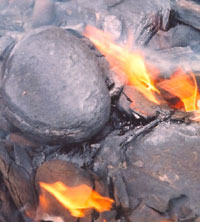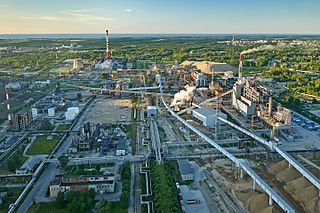Related Research Articles

Oil shale is an organic-rich fine-grained sedimentary rock containing kerogen from which liquid hydrocarbons can be produced. In addition to kerogen, general composition of oil shales constitutes inorganic substance and bitumens. Based on their deposition environment, oil shales are classified as marine, lacustrine and terrestrial oil shales. Oil shales differ from oil-bearing shales, shale deposits that contain petroleum that is sometimes produced from drilled wells. Examples of oil-bearing shales are the Bakken Formation, Pierre Shale, Niobrara Formation, and Eagle Ford Formation. Accordingly, shale oil produced from oil shale should not be confused with tight oil, which is also frequently called shale oil.
Shale oil is an unconventional oil produced from oil shale rock fragments by pyrolysis, hydrogenation, or thermal dissolution. These processes convert the organic matter within the rock (kerogen) into synthetic oil and gas. The resulting oil can be used immediately as a fuel or upgraded to meet refinery feedstock specifications by adding hydrogen and removing impurities such as sulfur and nitrogen. The refined products can be used for the same purposes as those derived from crude oil.

The oil shale industry is an industry of mining and processing of oil shale—a fine-grained sedimentary rock, containing significant amounts of kerogen, from which liquid hydrocarbons can be manufactured. The industry has developed in Brazil, China, Estonia and to some extent in Germany and Russia. Several other countries are currently conducting research on their oil shale reserves and production methods to improve efficiency and recovery. Estonia accounted for about 70% of the world's oil shale production in a study published in 2005.

Shale oil extraction is an industrial process for unconventional oil production. This process converts kerogen in oil shale into shale oil by pyrolysis, hydrogenation, or thermal dissolution. The resultant shale oil is used as fuel oil or upgraded to meet refinery feedstock specifications by adding hydrogen and removing sulfur and nitrogen impurities.
Oil shale economics deals with the economic feasibility of oil shale extraction and processing. Although usually oil shale economics is understood as shale oil extraction economics, the wider approach evaluates usage of oil shale as a whole, including for the oil-shale-fired power generation and production of by-products during retorting or shale oil upgrading processes.

The history of the oil shale industry started in ancient times. The modern industrial use of oil shale for oil extraction dates to the mid-19th century and started growing just before World War I because of the mass production of automobiles and trucks and the supposed shortage of gasoline for transportation needs. Between the World Wars oil shale projects were begun in several countries.
Independent Energy Partners, Inc. (IEP) is an oil shale resources company based in Parker, Colorado, the United States. It is a developer of the Geothermic Fuels Cells Process, an in-situ shale oil extraction process. CEO of the company is Alan K. Forbes.
Oil shale in China is an important source of unconventional oil. A total Chinese oil shale resource amounts of 720 billion tonnes, located in 80 deposits of 47 oil shale basins. This is equal to 48 billion tonnes of shale oil. At the same time there are speculations that the actual resource may even exceed the oil shale resource of the United States.
The TOSCO II process is an above ground retorting technology for shale oil extraction, which uses fine particles of oil shale that are heated in a rotating kiln. The particularity of this process is that it use hot ceramic balls for the heat transfer between the retort and a heater. The process was tested in a 40 tonnes per hour test facility near Parachute, Colorado.

Colony Shale Oil Project was an oil shale development project at the Piceance Basin near Parachute Creek, Colorado. The project consisted of an oil shale mine and pilot-scale shale oil plant, which used the TOSCO II retorting technology, developed by Tosco Corporation. Over time the project was developed by a consortium of different companies until it was terminated by Exxon on 2 May 1982 a day which is known amongst locals as "Black Sunday".
Chevron CRUSH is an experimental in situ shale oil extraction technology to convert kerogen in oil shale to shale oil. The name stands for Chevron's Technology for the Recovery and Upgrading of Oil from Shale. It is developed jointly by Chevron Corporation and the Los Alamos National Laboratory.
The Paraho process is an above ground retorting technology for shale oil extraction. The name "Paraho" is delivered from the words "para homem", which means in Portuguese "for mankind".
The Lurgi–Ruhrgas process is an above-ground coal liquefaction and shale oil extraction technology. It is classified as a hot recycled solids technology.
The Nevada–Texas–Utah retort process was an above-ground shale oil extraction technology to produce shale oil, a type of synthetic crude oil. It heated oil shale in a sealed vessel (retort) causing its decomposition into shale oil, oil shale gas and spent residue. The process was developed in the 1920s and used for shale oil production in the United States and in Australia. The process was simple to operate; however, it was ceased from the operation because of a small capacity and labor extensiveness.
The Superior multimineral process is an above ground shale oil extraction technology designed for production of shale oil, a type of synthetic crude oil. The process heats oil shale in a sealed horizontal segmented vessel (retort) causing its decomposition into shale oil, oil shale gas and spent residue. The particularities of this process is a recovery of saline minerals from the oil shale, and a doughnut-shape of the retort. The process is suitable for processing of mineral-rich oil shales, such as in the Piceance Basin. It has a relatively high reliability and high oil yield. The technology was developed by the American oil company Superior Oil.
The Union process was an above ground shale oil extraction technology for production of shale oil, a type of synthetic crude oil. The process used a vertical retort where heating causes decomposition of oil shale into shale oil, oil shale gas and spent residue. The particularity of this process is that oil shale in the retort moves from the bottom upward to the top, countercurrent to the descending hot gases, by a mechanism known as a rock pump. The process technology was invented by the American oil company Unocal Corporation in late 1940s and was developed through several decades. The largest oil shale retort ever built was the Union B type retort.
The Hytort process is an above-ground shale oil extraction process developed by the Institute of Gas Technology. It is classified as a reactive fluid process, which produces shale oil by hydrogenation.
The LLNL RISE process was an experimental shale oil extraction technology developed by the Lawrence Livermore National Laboratory. The name comes from the abbreviation of the Lawrence Livermore National Laboratory and words 'rubble in situ extraction'.
There are oil shale deposits in Australia which range from small deposits to large reserves. Deposits, varying by their age and origin, are located in about a third of eastern Australia. In 2012, the demonstrated oil shale reserves were estimated at 58 billion tonnes. The easiest to recover deposits are located in Queensland.
The history of the oil shale industry in the United States goes back to the 1850s; it dates back farther as a major enterprise than the petroleum industry. But although the United States contains the world's largest known resource of oil shale, the US has not been a significant producer of shale oil since 1861. There were three major past attempts to establish an American oil shale industry: the 1850s; in the years during and after World War I; and in the 1970s and early 1980s. Each time, the oil shale industry failed because of competition from cheaper petroleum.
References
- 1 2 3 Berry, Kay L.; Hutson, Roy L.; Sterrett, John S.; Knepper, Jay C. (1982). Modified In-Situ Retorting Results of Two Field Retorts. SPE Annual Technical Conference and Exhibition. New Orleans: Society of Petroleum Engineers. doi:10.2118/10998-MS. 10998-MS. Retrieved 2010-03-07.
- ↑ Youngquist, Walter (October 1998). "Shale oil — the elusive energy" (PDF). Hubert Center Newsletter. Colorado School of Mines (4). Retrieved 2010-03-07.
- 1 2 CER Geonuclear Corporation & Continental Oil Company (June 1975). "PROJECT RIO BLANCO FINAL REPORT DETONATION RELATED ACTIVITIES" (PDF). Retrieved 2015-05-10.
- ↑ United States Office of Technology Assessment (June 1980). An Assessment of Oil Shale Technologies (PDF). DIANE Publishing. pp. 133–136, 153. ISBN 978-1-4289-2463-5. NTIS order #PB80-210115. Retrieved 2007-11-03.
- ↑ Knutson, Carroll F. (1986). "Developments in Oil Shale in 1985". AAPG Bulletin. American Association of Petroleum Geologists. 70. doi:10.1306/94886C86-1704-11D7-8645000102C1865D.